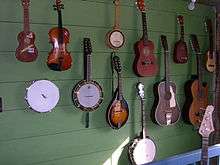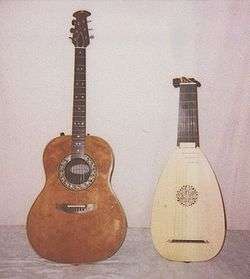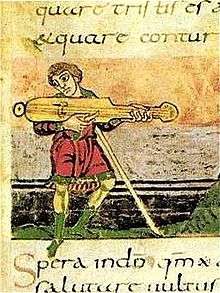Plucked string instrument
Plucked string instruments are a subcategory of string instruments that are played by plucking the strings. Plucking is a way of pulling and releasing the string in such a way as to give it an impulse that causes the string to vibrate. Plucking can be done with either a finger or a plectrum.

Most plucked string instruments belong to the lute family (such as guitar, bass guitar, mandolin, banjo, balalaika, sitar, pipa, etc.), which generally consist of a resonating body, and a neck; the strings run along the neck and can be stopped at different pitches. The zither family (including the autoharp, kantele, gusli, kannel, kankles, kokles, koto, guqin, gu zheng and many others) does not have a neck, and the strings are stretched across the soundboard. In the harp family (including the lyre), the strings are perpendicular to the soundboard and do not run across it. The harpsichord does not fit any of these categories but is also a plucked string instrument, as its strings are struck with a plectrum when the keys are depressed.
Bowed string instruments, such as the violin, can also be plucked in the technique known as pizzicato; however, as they are usually played with a bow, they are not included in this category. Struck string instruments (such as the piano) can be similarly plucked as an extended technique.
Plucked string instruments are not a category in the Sachs-Hornbostel classification, aside from 335 and 336, as some of them are simple chordophones and others are composite (depending on whether the resonator is the removable part of the instrument). This is possible due to the Lute family
List of plucked string instruments
- 3rd bridge guitar
- Appalachian dulcimer (United States)
- Autoharp
- Bağlama (Turkey)
- Baglamas (Greece)
- Bajo sexto (Mexico)
- Balalaika (Russia, Ukraine, Belarus)
- Bandura (Ukraine)
- Bandurria (Spain)
- Bandolin (Ecuador)
- Banjo (American)
- Banjolele (United Kingdom)
- Barbat (Iran)
- Begena (Ethiopia)
- Bordonua
- Bouzouki (Greece)
- Bugarija (Croatia)
- Cak (Indonesia)
- Cavaquinho (Portugal and Brazil)
- Çeng (Turkey)
- Charango (South America)
- Chitarra battente (Italy)
- Çiftelia (Albania and Kosovo)
- Citole
- Cittern
- Cobza (Romania and Hungary)
- Contrabass
- Cuatro
- Cuk (Indonesia)
- Cümbüş (Turkey)
- Đàn bầu (Vietnam)
- Đàn nguyệt (Vietnam)
- Đàn tam (Vietnam)
- Đàn tranh (Vietnam)
- Đàn tỳ bà (Vietnam)
- Daruan (China)
- Diddley bow (United States)
- Dombra (East Europe and Central Asia)
- Domra (Russia, Ukraine, Belarus)
- Doshpuluur (Tuva)
- Dotara (India)
- Double Bass
- Dutar
- Duxianqin (China)
- Ektara (India)
- Electric bass
- Gayageum (Korea)
- Geomungo (Korea)
- Gittern
- Gottuvadhyam (India)
- Guitar
- Classical guitar
- Solid-body classical guitar
- Acoustic guitar
- Steel-string acoustic guitar
- Bass guitar
- Acoustic bass guitar
- Chapman Stick
- Cigar box guitar
- Electric guitar
- Harp guitar
- Resonator guitar (a.k.a. dobro)
- Lyre-guitar
- Guitarrón chileno
- Guitarrón mexicano
- Gusli (Russia)
- Guqin (China)
- Guzheng (China)
- Harp
- Harpsichord (Europe, keyboard instrument)
- Irish bouzouki
- Jakhe (Thailand)
- Jarana huasteca (Mexico)
- Jarana jarocha (Mexico)
- Jouhikko (Finland, Karelia)
- Jumbush (Turkey)
- Kacapi (Indonesia)
- Kanklės (Lithuania)
- Kantele (Finland)
- Kithara (Ancient Greece)
- Kobyz (Kazakhstan)
- Kobza (Ukraine)
- Kokles (Latvia)
- Konghou (China)
- Kontigi (Nigeria)
- Komuz (Central Asia)
- Kora (West Africa)
- Koto (Japan)
- Krar (Ethiopia)
- Kutiyapi (Philippines)
- Langeleik (Norway)
- Laúd
- Liuqin (China)
- Lute (Europe)
- Lyre (Ancient Greece, Sumer)
- Mandolin family
- Mandolin
- Mandore (instrument)
- Mandola
- Octave mandola
- Mandocello
- Mandobass
- Mandolone
- Laouto (Greece, Cyprus, Romania, Albania)
- Mandolin-banjo (a crossover instrument, not part of the mandola family)
- Mejoranera
- Mohan veena
- Monochord
- Morin khuur (Mongolia)
- Musical bow
- Nyatiti (Kenya)
- Octavina (Philippines)
- Oud (Middle East, Greece)
- Pandura
- Panduri (Georgia)
- Phandar (Chechnya and Ingushetia)
- Pipa (China)
- Portuguese guitar
- Psaltery
- Qanún/kanun (Middle East, Persia, Greece)
- Qanbūs (Arabian Peninsula)
- Qinqin (China)
- Rawap
- Requinto
- Rote
- Rubab (Iran)
- Rudra veena (India)
- Sagar veena (Pakistan)
- Sallaneh (Iran)
- Sanxian (China)
- Saraswati veena (India)
- Šargija (Eastern Europe)
- Sarod (India)
- Sasando (Indonesia)
- Saung (Burma)
- Swaraj (India)
- Saz (Turkey)
- Setar (Iran)
- Shamisen (Japan)
- Sitar (India)
- Tambura
- Tamburitza (Pannonian plain)
- Tanbur(Iran)
- Tar(Iran)
- Tea chest bass
- Tiple
- Torban
- Tremoloa
- Tres (Cuba)
- Ukulele (Hawaii)
- Valiha (Madagascar)
- Veena (India)
- Vichitra veena (India)
- Vihuela (Spain)
- Viola toeira (Portugal)
- Yueqin (China)
- Zhongruan (China)
- Zhu (China)
- Zither

